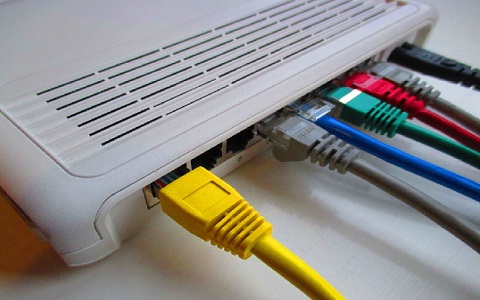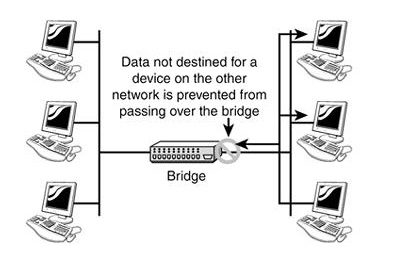Bridge in a Computer Network : Types, Uses and Its Functions
The computer network is the basis of communication in the field of IT (information technology). These networks are used in different ways by using different types of networks. The connection of a computer network can be done by connecting a set of computers so that the information can be shared. Historically, these networks are broken down into topologies, used for connecting computers. At present, the most commonly used topology is a collapsed ring because, this type of protocol supports the internet, LANs & WANs. Computer networks are used to share information by carrying a large number of tasks. Some of the functions of this network are communication with the help of an e-mail, messaging, video and device sharing like scanners, printers, sharing files, software’s and permitting the users of the network to access and maintain the information easily. This article discusses an overview of a bridge in a computer network.
Mục Lục
What is a Bridge in a Computer Network?
Definition: A bridge in a computer network is one kind of network device, used to separate a network into sections. Every section in the network represents a collision domain that has separate bandwidth. So that network performance can be improved using a bridge. In the OSI model, a bridge works at layer-2 namely the data link layer. The main function of this is to examine the incoming traffic and examine whether to filter it or forward it.

Working Principle
The working principle of a bridge is, it blocks or forwards the data depending on the destination MAC address and this address is written into every data frame.

In a computer network, a bridge separates a LAN into different segments like segment1 & segment2, etc and the MAC address of all the PCs can be stored into the table. For instance, PC1 transmits the data to PC2, where the data will transmit to the bridge first. So the bridge reads the MAC address & decides whether to transmit the data to segment1 or segment2. Therefore, the PC2 is accessible in segment1, which means the bridge transmits the data in segment1 only & eliminates all the connected PCs in segment2. In this way, the bridge reduces traffic in a computer network.
Use of Bridge in Computer Network
A bridge in a computer network connects with other bridge networks that utilize a similar protocol. These network devices work at the data link layer in an OSI model to connect two different networks and provide communication between them. Similar to hubs and repeaters, bridges broadcast data to each node. But, maintains the MAC (media access control) address table to find out new segments. So following transmissions are transmitted to the preferred receiver only.
A bridge utilizes a database to determine where to transmit otherwise remove the data frame.
Types of Bridges
Bridges in the computer network are classified into three types which include the following.
Transparent Bridge
As the name suggests, it is an invisible bridge in the computer network. The main function of this bridge is to block or forward the data depending on the MAC address. The other devices within the network are unaware of the existence of bridges. These types of bridges are most popular and operate in a transparent way to the entire networks which are connected to hosts.
This bridge saves the addresses of MAC within a table that is similar to a routing table. This estimates the information when a packet is routed to its position. So it can also merge several bridges to check incoming traffic in a better way. These bridges are implemented mainly in Ethernet networks.
Translational Bridge
A translational bridge plays a key role in changing a networking system from one type to another. These bridges are used to connect two different networks like token ring & Ethernet. This bridge can add or remove the data based on the traveling direction, and forward the frames of the data link layer in between LANs which uses various types of network protocols. The different network connections are Ethernet to FDDI/token ring otherwise Ethernet on UTP (unshielded twisted pair) to coax & in between FOC and copper wiring.
Source-route Bridge
Source-route Bridge is one type of technique used for Token Ring networks and it is designed by IBM. In this bridge, the total frame route is embedded in one frame. So that it allows the bridge to make precise decisions of how the frame is forwarding using the network. By using this method, two similar network segments are connected to the data link layer. It can be done in a distributed way wherever end-stations join within the bridging algorithm.
Functions of Bridges in Network
The main functions of bridges in a computer network include the following.
- This networking device is used for dividing local area networks into several segments.
- In the OSI model, it works under the data link layer.
- It is used to store the address of MAC in PC used in a network and also used for diminishing the network traffic.
Advantages/Disadvantages of Bridge in Computer Network
The advantages are
- It acts as a repeater to extend a network
- Network traffic on a segment can be reduced by subdividing it into network communications
- Collisions can be reduced.
- Some types of bridges connect the networks with the help of architectures & types of media.
- Bridges increase the available bandwidth to individual nodes because fewer network nodes share a collision domain
- It avoids waste BW (bandwidth)
- The length of the network can be increased.
- Connects different segments of network transmission
The disadvantages are
- It is unable to read specific IP addresses because they are more troubled with the MAC addresses.
- They cannot help while building the network between the different architectures of networks.
- It transfers all kinds of broadcast messages, so they are incapable to stop the scope of messages.
- These are expensive as we compare with repeaters
- It doesn’t handle more variable & complex data load which occurs from WAN.
Thus, this is all about an overview of the bridge in a computer network. These are passive devices as there is no communication between the bridged as well as bridging paths. These are very useful in data load filtering of the network traffic by separating it into packets or segments. These are useful for reducing the load traffic on the networks. These works at the second layer within the OSI model namely the data link layer, Here is a question for you, what are the networking devices in the computer network.















![Toni Kroos là ai? [ sự thật về tiểu sử đầy đủ Toni Kroos ]](https://evbn.org/wp-content/uploads/New-Project-6635-1671934592.jpg)


